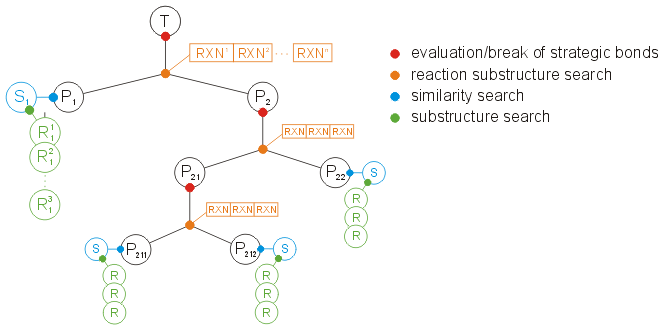Synthesis Design
In combinatorial chemistry, hundreds of thousands of reactions are run in parallel, on beads, or simultaneously in solution. A careful planning of these reactions is therefore of paramount importance in order to influence the products obtained in these experiments.
The system WODCA (Workbench for the Organization of Data for Chemical Applications) has been developed to assist in the planning of the synthesis of individual target compounds. Work of recent years now also enables its use in designing entire libraries of compounds.
If the synthesis of an individual organic compound or a combinatorial library is planned the most important questions for an organic chemist are: which suitable starting materials are (commercially) available for the synthesis of the target compound? What is the most convenient and efficient synthesis towards the target compound? Are there any powerful synthesis reactions? And, especially if the synthesis of combinatorial library is planned, which structural manifoldness of my starting materials is available? The objective of the methods incorporated in WODCA is to provide solutions for all of these questions. The chemist is supported during each step of the synthesis planning process by means of an interactive use of the tools and methods implemented in WODCA.
Important methods in WODCA are:
- Similarity Searches
Similarity searches are essential methods in WODCA to be used to generate a relationship between the synthesis target or precursors and available starting materials. Similarity searches in WODCA are performed on the basis of similarity criteria that are either based on the presence of substructures or on generalized reactions. - Substructure Searches
Substructure searches provide an additional method to search for suitable starting materials. Although they can be also helpful during the synthesis planning of an individual target compound the application of substructure searches is more important during the design of compound libraries. In conjunction with the search for strategic bonds, substructure searches can provide a series of representatives of certain classes of compounds that can act as precursors for the synthesis of an entire library. - Strategic Bonds (Evaluation and Disconnection)
An important method for synthesis planning is the ability to search for and to evaluate strategic bonds. The next step after the evaluation of strategic bonds is the disconnection of the target compound at selected strategic bonds into suitable synthesis precursors. Strategic bonds can be defined either automatically by the program or manually by the chemist. - Reaction Substructure Searches
In order to verify a synthesis step suggested by WODCA a direct connection to reaction databases has been established in the most recent version of WODCA. It is implemented on the basis of reaction substructure searches in a local reaction database. After one or more strategic bonds have been broken a corresponding number of precursors is generated. The precursors in conjunction with the target compound are defining a conceivable synthesis step containing the reaction site and all participating compounds. The position of the chosen strategic bond locates the reaction center. For the deduction of the reaction substructure the user can select between a number of rules generating the reaction substructure query to the database on the basis of bond spheres and/or functional groups around the strategic bond.

Publications:
Ihlenfeldt, W.-D.; Gasteiger, J.:
Computer-Assisted Planning of Organic Syntheses: The Second Generation of Programs.
Angew. Chem. Int. Ed. Engl. 1995, 43, 2613-2633.
Gasteiger, J.; Pförtner, M.; Sitzmann, M.; Höllering, R.; Sacher, O.; Kostka, T.; Karg, N.:
Computer-Assisted Synthesis and Reaction Planning in Combinatorial Chemistry.
Persp. Drug Discov. Design 2000, 20, 245-264.
Last modified: 8. Jan. 2003,
A. Schunk
